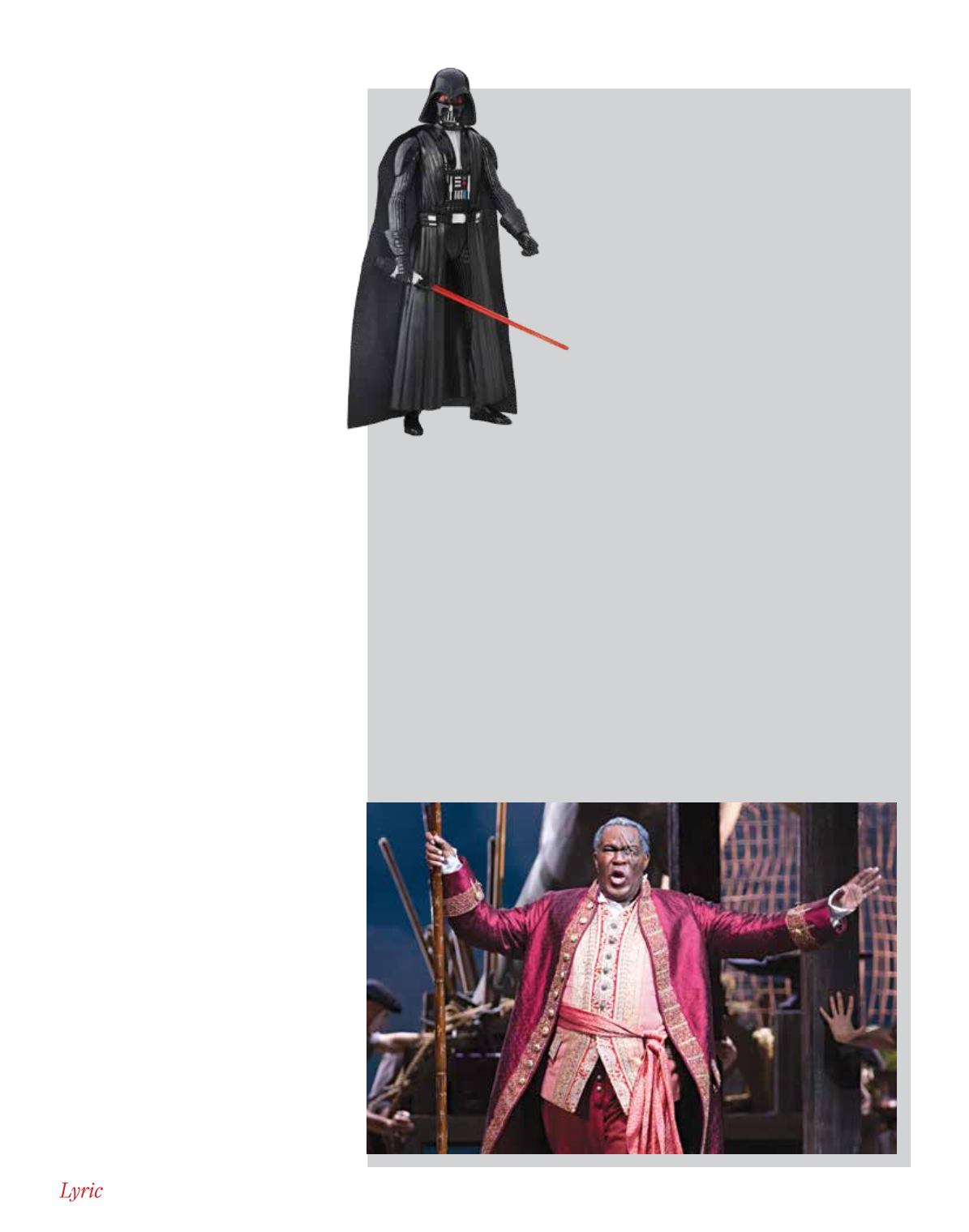

O P E R A N O T E S | L Y R I C O P E R A O F C H I C A G O
November 1 - 30, 2017
|
33
NCAA championships. Perhaps their music
has become a bit of a cliché but the Valkyries’
attitude was more than a century ahead of its
time.
Wotan is never angrier than when he
confronts Brünnhilde in Act Three. She is his
favorite daughter, the only Valkyrie to whom
he would confide his innermost thoughts,
the one he allowed to “serve me mead at my
table” and who protects his back in battle.
Now she has betrayed him. But because
of their special relationship, the humiliated
Brünnhilde senses her father still regards
her dearly. Once she persuades “warfather”
to surround her with flames so that “only a
fearless noble hero will find me,” the ultimate
glories of
Die Walküre
are released.
Had Wagner not written another
opera, he would be remembered for Wotan’s
farewell, music of tremendous emotion
that accompanies this most conflicted of
fathers who must say goodbye to his beloved
daughter. The swelling music leaves the strife
behind and begins to incorporate elements of
Valhalla, the Valkyries, the sleep motif, the
coming of Siegfried in the next opera and,
eventually, Loge’s magic fire theme, called by
some wags the “heat motif.”
Long gone are the pyrotechnics of the
Siegmund-Sieglinde love duet, replaced by
music of profound tenderness. Any father
who seen a daughter leave home, be it for
college, work or marriage, knows the emotion
that accompanies such partings.
“On a happier man may your eyes
shine,” sings Wotan as music from the strings
and horns sends Brünnhilde into a magical
sleep. No doubt, Wotan is diminished from
the master of the universe he sought to
portray at the start of
Die Walküre
. Yet he is a
far nobler character. Through unexpected and
tortuous paths, Wotan, now a sympathetic
father, has earned our respect and admiration,
and his farewell brings a glorious benediction
to this most beloved of
Ring
operas.
Richard Rothschild
of Oak Park has written
about opera for more than 30 years, including
during a 21-year stint at the Chicago Tribune. One
of the first operas he attended was Wagner’s
The
Flying Dutchman
at the original Metropolitan
Opera House in New York.
Modern Match – The
Ring
Cycle
Iconic melodies can pull in listeners after hearing the first few notes.
Wagner’s “Ride of the Valkyries” is no exception to this phenomenon;
used in platforms such as commercials and movies, this melody is
everywhere! But when all is said and done, it brings listeners back to
its roots:
Die Walküre/Ring
cycle/opera. The “Ride” isn’t the only melody to
do this. In fact, if asked to hum the theme song to George Lucas’s
Star Wars
, everyone in the audience probably could, whether
they’ve seen the movies or not! These two franchises – Wagner’s
tetralogy and
Star Wars
– have more in common than melodies that
everyone knows. For starters, both works of art are unusual. There
aren’t many operatic tretralogies! The Ring consists of four
separate operas (
Das Rheingold, Die Walküre, Siegfried,
Götterdämmerung
), making for more than 15 hours of
music. Similarly,
Star Wars
began as a trilogy but now encompasses
no fewer than eight movies (the ninth will premiere in 2019). Most
operas are stand-alone, and while movie sequels and trilogies have
been becoming more popular, not many can boast of eight+ movies
in their franchise, making Wagner and Lucas’s works one of a kind.
These rarities take time to create; Wagner took nearly two decades to write all four
operas.
Star Wars
first premiered in 1977 and is still being rethought today, 30 years later. With
decades of dedication also come decades of built-up excitement around the pieces. The massive
fan support over both Wagner’s
Ring
cycle and
Star Wars
put these two works above and beyond
any others in their genres.
However, the biggest comparison between these two would have to be the family drama
portrayed throughout both. Powerful fathers, orphans, and long-lost siblings are among the
numerously comparable archetypes in these series. Anakin Skywalker, a.k.a. Darth Vader, is the
powerful and unknown father featured in
Star Wars
while Wotan, King of the Gods, is the father
in the
Ring
cycle. Orphaned Luke Skywalker must defeat his own father (Darth Vader!), to rise
above evil, while orphaned Siegfried must defeat his adopted father (Mime) and grandfather
(Wotan) on his way to save Brünnhilde. Each series also features a set of long-lost siblings
audiences know and love: Luke and Leia, Siegmund and Sieglinde.
With iconic melodies, hours and hours of entertainment, years of hard work, and notorious
characters, the parallels between the
Ring
and
Star Wars
are hard to miss. We can be certain that
audiences worldwide will adore them both for decades to come!
— Margaret Rogers
The author, Lyric’s dramaturgy intern during the summer,
is a senior at the University of Minnesota.
TODD ROSENBERG
George Lucas's Darth Vader
(above) and Wagner's Wotan,
portrayed by Eric Owens in
Lyric's 2016/17 production of
Das Rheingold
.
















